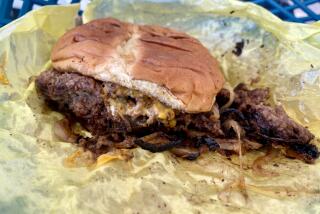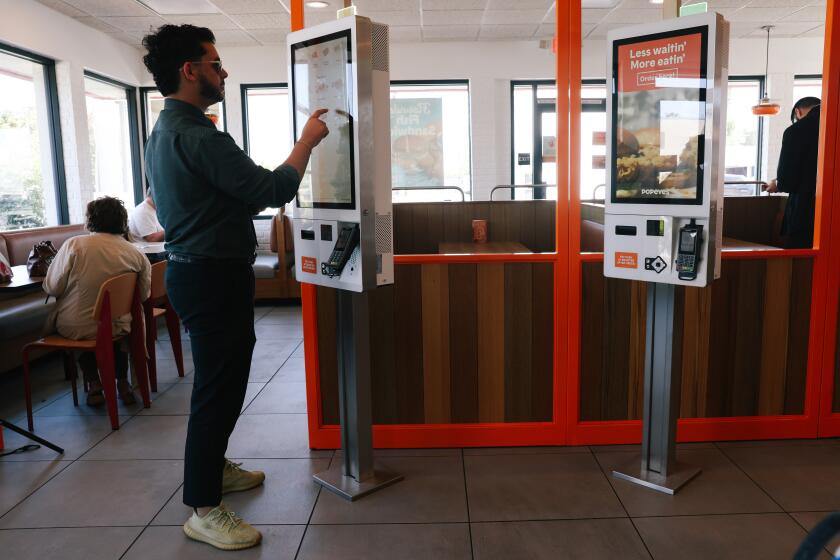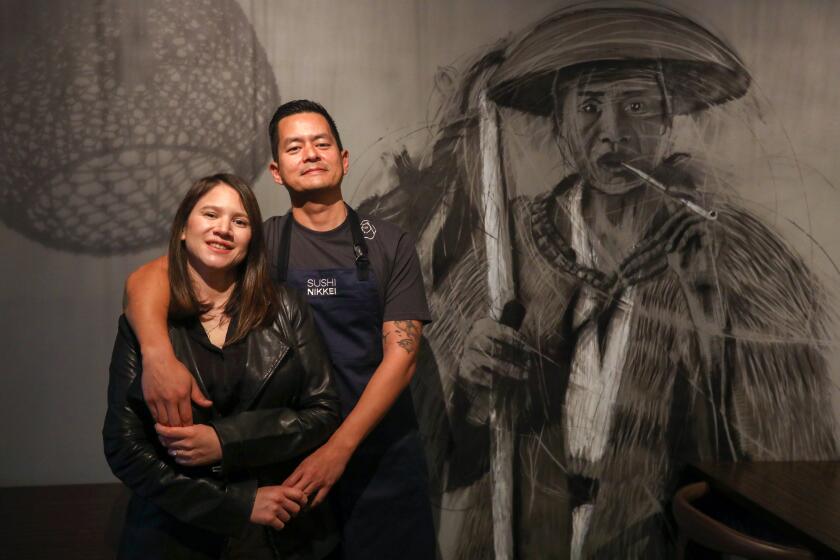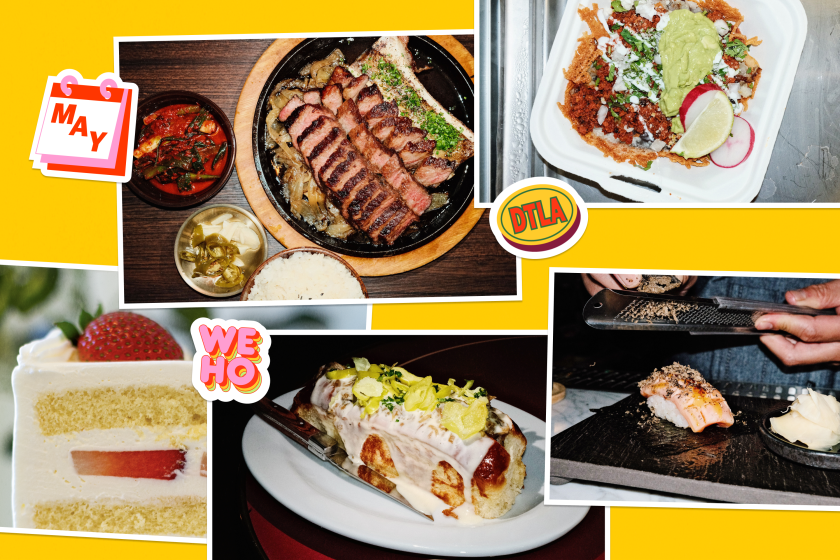EASTER FEASTS : Centuries of Tradition Behind Religious Holiday
“Ester daie is a tyme of ioiful refeccion and fedinge,” wrote a 12th-Century author. Long before the advent of chocolate bunnies and marshmallow eggs, Easter was already one of the world’s major feast days.
After six arduous weeks of Lenten austerity, the entire Christian world was anxious to sit down to a good meal. That they did so with joy and gusto can be seen from household accounts of the day. On Easter Sunday, 1289, a party of 80 people at the English Bishop Swinfield’s managed to put away the following feast: two boars, five pigs, 4 1/2 calves, 22 kids, three fat deer, 12 capons, 88 pigeons, 1,400 eggs, 1 1/2 carcasses of salt beef, one bacon, 1 3/4 carcasses of fresh beef, bread, cheese, unlimited beer and 66 gallons of wine.
Some six centuries later, habits had hardly changed. In 1901 Henrietta Sowle, a cookbook writer, was advising her New England readers how to spend their Easter Sundays. “The very first thing to be done,” she wrote, “is to get up in time to see the sun dance.” And, of course, to eat. To break the fast, Sowle prescribed a modest meal of broiled shad roes, crisp salted lettuce hearts, graham bread and a cup of English breakfast tea. This, she felt, ought to offer sufficient sustenance to permit the ladies to parade in their Easter bonnets.
But the eating was far from over. “Dear knows I hope you won’t see any headgear that will take the shine off your own,” Sowle said, anxious for her readers to hurry home and cook a charming little Easter dinner. This consisted of clam cocktails (“made, of course, with the little-neck variety”), consomme, trout “broiled to a nicety and served with tartar sauce and some delicious hothouse cucumbers.”
But these were mere morsels, serving mainly to whet the appetite for what was yet to come. The feast continued with lamb steak (“never under any circumstances,” Sowle said, “serve a lamb steak without a Bearnaise sauce. It would be barbarism!”) The meat was to be accompanied by piles of pommes souffles and a salad of new beets. And then, of course, dessert.
What her readers were to do for the rest of the afternoon, Sowle never says.
These days we may not eat quite so copiously, but Easter is still a time for feasting. For those who go out to eat, it can also be a time to see how this particularly edible holiday is celebrated in other parts of the world. Every culture has its own special Easter habits, and on this particular day, Los Angeles turns into a movable feast.
(Unless you are willing to do a bit of moving yourself, however, do not attempt to eat at any of these restaurants without calling first for reservations. If you try popping in for a bite after church, you may find yourself out of luck. And if you have children in tow, keep in mind that in addition to the last brunch on the list, almost all hotels in town will be offering Easter brunches with special prices for children.)
GREEK
Devout Greeks abstain from eating meat during Lent--but they go farther than that. During Holy Week they also eliminate eggs, milk and even fish from their diet. This makes the arrival of Easter a particularly festive event.
Easter in Greece begins with fireworks. Services are held on Saturday evening, and when they end at midnight the fun begins. The fireworks go off--and the tablecloths go on. One 19th-Century visitor wrote, “The versatile Greeks are now as ardent and eager in the pursuit of pleasure as they were but an hour previously in that of salvation.” They sing and dance through the night--and all day Sunday Homeric feasts are served.
In Sherman Oaks the Great Greek will be open late tonight to welcome feasters as they return from church services. The restaurant remains open “until whenever”--and then reopens on Sunday morning to serve a true Greek Easter meal.
A Macedonian proverb says “Easter without lamb is a thing which cannot be.” But while waiting for the lamb to cook, mezedes-- the wonderful Greek appetizers-- are abundantly served. These include taramasalata, eggplant salads, salads made of fresh yogurt, mint and cucumbers and stuffed grape leaves. There are pies made of infinite layers of flaky pastry filled with spinach and feta cheese. There are soups--and, of course, the very special baby lamb of spring. To finish, there is the classic Greek Easter cake called Tsoureki.
In the Greek tradition the tables are covered with red eggs. Custom calls for people to roll their eggs against those of their tablemates while saying, “Christos Anesti” (Christ has been resurrected). The proper reply to this is “Alithos Anesti” ( He has indeed risen.) The person whose egg does not crack is slated for good luck.
The Great Greek, 13362 Ventura Blvd., Sherman Oaks. (818) 905-5250. Easter dinner is served 11:30 a.m.--11:30 p.m. Complete feast $16.95 per person (a la carte dishes also available) .
ITALIAN
“In Italy,” chef Alfredo Viazzi writes, “the observance of the Easter lamb feast is almost in the nature of a pagan rite. Italians must have that baby lamb, no matter what their financial circumstances.”
They will be serving baby lamb at the traditional Italian Easter dinner at Prego--but eating it will not require extraordinary financial resources.
The meal at this warm and casual trattoria begins with an Easter soup called brodetto pasquale made of beef and lamb broth with Parmesan cheese, egg yolk, lemon and toasted croutons. The roasted baby lamb comes next, accompanied by springtime artichoke fritters. To end the meal there is ciambella, a ring-shaped pastry from Romagna. By custom, the shell of the first egg that goes into the ciambella is broken on the head of a small boy to ward off bad luck.
Prego, 362 N. Camden Drive, Beverly Hills. (213) 27-PREGO. Easter dinner is served from 5 p.m. to midnight. Cost is $17.50 per person.
ENGLAND
Although lamb figures prominently in Easter meals of many lands, English tradition has always centered on beef. Thomas Tusser, a 16th-Century author on farm and household management, advised his readers to prepare for Easter in the fall when meat was plentiful and prices low. Cattle slaughtered on Martinmas (Nov. 11), he said, could be hung to smoke in the chimney throughout the winter. According to Tusser, it would then make a perfectly economical centerpiece for a proper Easter dinner.
If beef is your meat, you could hardly do better than to eat your Easter dinner at Lawry’s. This bastion of tradition will be serving a dinner of beef (you can now choose from three different sized cuts of prime rib), creamed spinach, creamed corn, Yorkshire pudding and potatoes. To finish off in fine style, there is English trifle or chocolate cream pie.
Lawry’s The Prime Rib, 55 N. La Cienega Blvd, Beverly Hills. (213) 652-2827 Easter dinner is served from 3 p.m.-10 p.m. Cost is $15.95-$21.95 per person.
CAJUN
Mardi Gras, of course, is the great Cajun holiday. It’s the time of year when people in New Orleans put on costumes and get wild and silly, while out in Cajun country, they go even further. The beginning of Lent is observed in the bayous with pranks like stealing the neighbors’ chickens.
If that is how they greet the beginning of the Lenten fast, just imagine how they behave six weeks later when it ends. One thing you can be certain of--when Easter comes to the bayou, the Cajuns eat.
And eating is exactly what they’ll be doing at the rollicking Orleans restaurant, where Easter will be celebrated with a very special brunch. Champagne (or freshly squeezed orange juice) will make things even merrier. To begin, there is a choice of broccoli bisque, Cajun artichoke croquettes, marinated eggplant, roasted peppers and crawfish, or a crawfish salad.
Entrees include--don’t laugh--Cajun corned beef with peppercorn sauce and jalapeno potatoes or a Cajun version of eggs Benedict called Eggs Orleans. This is served on a jalapeno cheese roll with Tasso ham and an oyster buttercream sauce. Other choices include either crepes or a Cajun seafood enchilada.
Dessert? Easter wouldn’t be Easter in Cajun country without lots and lots of sweets. Let the good times roll!
Orleans, 11705 National Blvd, West L.A.. (213) 479-4187. Easter brunch is served from 11 a.m.-3:30 p.m. Cost is $15 for adults, $8 for children.
FRANCE
“There is too much wine in the world to say Mass, not enough to turn the mills, therefore we must drink it,” said the 18th-Century gourmet Grimod de la Reyniere, proving once again that when it comes to the table, the French are never anything but pragmatic.
And Easter is no exception. As far as the French are concerned, Easter is yet another opportunity to prove that they are the world’s greatest cooks. And if you are in the market for a Gallic Easter feast, you can hardly do better than the lamb dinner served at the venerable Le Cellier.
This charming old world restaurant will be serving a special meal of sauteed loin of lamb on a bed of red and white cabbage in a shallot and black pepper sauce. On the side will be poached pears in red wine and home made spaetzle noodles. “A leg of lamb is really more traditional,” says the chef, “but we thought that this would be more delicious and more interesting.”
Le Cellier, 2628 Wilshire Blvd., Santa Monica. (213) 828-1585. Easter dinner served from 4:30 p.m.-9:30 p.m. Cost is $19.50 per person.
GERMANY
In the old days in northern Europe, herring was king during Lent. It was easy to catch, easy to cure and easy to keep. And after six endless weeks of salted fish, the last dish anybody wanted to see gracing the Easter table was anything with fins.
Knoll’s Black Forest Inn will be serving a proper German brunch for Easter--with one minor exception. There will be Nuremburg style sausages with champagne sauerkraut, and there will be cream of veal soup. There will be the traditional lamb chops, roast veal or pork filet. But chef Norbert Knoll has taken pity on those who haven’t had their fill of fish, and while there will not be any herring on this typically German menu, there will be grilled salmon with the new asparagus of the season.
Knoll’s Black Forest Inn, 2454 Wilshire Blvd., Santa Monica. (213) 395-2212. Easter brunch served from 11 a.m.-3 p.m. The cost is $22 per person.
OLD-TIME EATING
In 1923, the Biltmore bought a classic silver service, put it away a couple of years later and promptly forgot about it. It was not rediscovered until the recent restoration of the hotel and it later occurred to the management that Easter might be the perfect time to resurrect the silver.
For its elegant Easter brunch, Bernard’s in the Biltmore will be serving a three-course meal accompanied by champagne and harp music. The renovated room is hushed and dark and almost church-like, with spots of light pointing out a rose here, a detail of the painted ceiling there. The menu is also very posh, offering a choice of lobster fettucine, various fish, lamb and veal, or a variety of omelets. Desserts are offered from a self-service pastry buffet.
Henrietta Sowle, I feel certain, would approve.
Bernard’s, Biltmore Hotel, 515 S. Olive St. (213) 612-1580. Easter brunch is served from 10 a.m.-2 p.m. Cost depending on entree selection, ranges from $18.95 to $31.95 per person.
DOWN-HOME EATING
If all this exotica is not your cup of tea, and what you really want is the kind of meal your mother used to make, the bright and cozy Yanks is the place for you. This is one of the city’s nicest neighborhood restaurants, a cheerful room with the whitewashed air of a tidy New England cottage. It’s a perfect place for a sunny brunch--and all the good old Easter favorites will be served.
In the daytime they’ll be serving everything from French toast to poached eggs with red flannel hash and southern fried catfish. On the side will be a bread basket plentifully filled with pecan rolls, onion thyme biscuits and bran and banana muffins. At dinner, there will be rack of lamb with new potatoes and minted peas as well as baked country ham with sweet potatoes and green beans.
And to finish? What could be homier than blackberry peach pie?
Yanks, 262 S. Beverly Drive, Beverly Hills. (213) 85-YANKS. Easter brunch served 11 a.m.-3 p.m. Cost is $10-$15 per person. Easter dinner served 5-9:30; cost is $15-$20 per person.
EATING WITH
THE EASTER BUNNY
For a truly excessive Easter celebration, nothing tops the one planned by the Filmland Center in Culver City. It sounds like a great event for children. Bunnies will abound: In addition to real live rabbits in a special house, there will be rabbits carved out of ice and even Miss Easter Bunny anxious to pose for pictures with the kids. As if that were not enough, the Westside’s largest Easter egg is promised, as well as lots of lillies and live Dixieland music.
The food sounds equally excessive. You name it, they’ve got it, from a seafood bar to Belgian waffles, blintzes, leg of lamb, baked ham, duck a l’orange, whole decorated salmon--the list goes on and on. And when you’ve eaten your fill, there’s always the Easter egg hunt.
Filmland Center, 10000 Washington Blvd., Culver City. (213) 280-1201. Easter brunch is served from 11 a.m.-5 p.m. Cost is $19.50 for adults, $9.50 for children under 10.
More to Read
Eat your way across L.A.
Get our weekly Tasting Notes newsletter for reviews, news and more.
You may occasionally receive promotional content from the Los Angeles Times.






